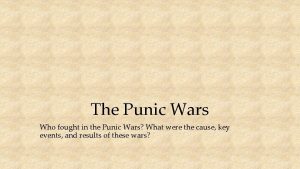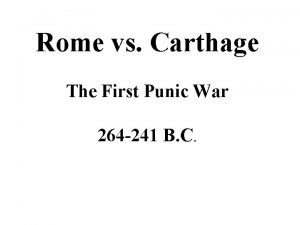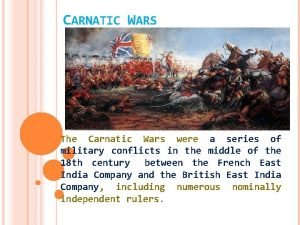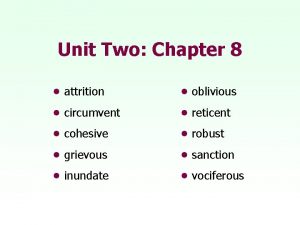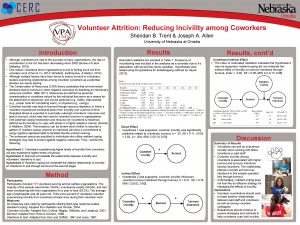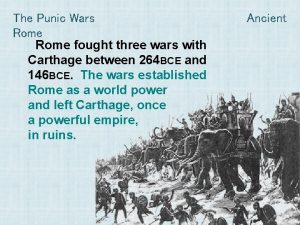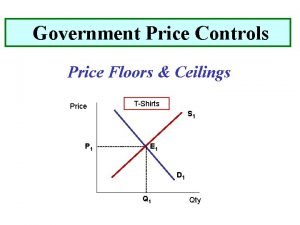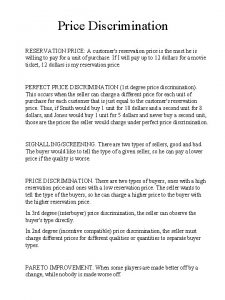Wars of Attrition Examples n Price wars fought




















- Slides: 20

Wars of Attrition

Examples n Price wars fought to drive out new entrants into some market Holland Sweetener n Rate cutting by Kiwi. Air competitors n Browser wars n n Technology battles among established players DRAMS in the 1970 s n LCD screen technology in the 2000 s n

More Examples n Labor negotiations n Professional sports lockouts/cancellations n Anthracite coal strikes in early 20 th century n Caterpillar’s labor dispute n Standards wars n VHS v Beta n 56 k modems n BSB v Sky n Entry in emerging markets n E-retailing wars of the 1990 s

Recognizing Wars of Attrition n Costly for all sides to endure the “fighting” period n Reward to the “winner” of the war n No fixed endpoint to the fighting

Modeling Wars of Attrition n Two competing players (1 and 2) n If player 1 wins, it earns a prize equal to v 1 n If player 2 wins, it receives a prize equal to v 2 n It costs each player 1 per “period” to fight the war.

Payoffs n Suppose the war lasts for time t at which point firm 2 drops out. n Then player 1 earns n Profit 1 = v 1 – t n And player 2 earns n Profit 2 = - t

Connection to Auctions n Notice that we could think of this as a kind of auction n Each player “bids” an amount of time they want to pursue the war. Player 1 “bids” t 1 n Player 2 “bids” t 2 n n Suppose that t 2 < t 1 then player 2 drops out first n The war lasts until the time player 2 drops out t 2.

More Connection to Auctions n The winning bidder, player 1, pays player 2’s bid (like in the Vickrey auction) n But the losing player pays its own bid (unlike the Vickrey auction).

How Much Should I Bid? n Clearly, the amount of the bid depends on the value of the reward n Suppose values are uniformly distributed on [0, 1]. n Then we can use our usual formulation of bidding in auctions to analyze the game

Profit Maximization n Suppose that my rival is using a bidding strategy t(v). n I need to choose how much to “bid, ” T, to maximize Profit 1 = Pr(t(v)<T) (v – E[t(v)|t(v) < T]) – Pr(t(v) > T) T n The top of the profit “hill” is given by: n n n dt/dv = v/(1 - v) Solving this equation yields the equilibrium n t(v) = - v – ln(1 – v)

How to Bid – Graphically n Let’s look at this bidding function on a graph Bid Value

Interpretation n For values close to the highest possible value, the “bids” get arbitrarily large For v >. 8, bids already exceed 1, the maximum value of the reward n For v close to. 9, bids are already around 6 n n The point is that even with completely rational bidders, wars of attrition can last a very long time

An Example n Suppose that v 1 =. 95 and v 2 =. 9 n Then the war of attrition will t = 1. 4 --- both sides will end up losing money n If v 2 also equals. 95, the war of attrition will last more than t = 2 – both sides are bidding more than twice as much as what the prize is worth to either n Can this really be rational? n Are these credible threats?

More intuition n Consider the case where v 1 =. 95 and v 2 =. 9 n Suppose that each side has already spent 1 in fighting the war. n Both sides are certain to lose money n Should player 1 continue? n Marginal benefit: There’s a small chance that player 2 will give up soon and I’ll earn the prize of. 95 n Marginal cost: The tiny cost of persisting for the next small time period

Key insight n As long as a player believes that the chance of concession by the rival is high enough, it pays to keep fighting the war n How do you judge this probability? Financial capabilities n Reputation/past actions n Estimates of valuation of “prize” to rival n n Competitor analysis is crucial in determining this probability

Key Pitfall n Often, firms competing in wars of attrition reason this way: n n If I maintain the fight, I’ll obtain the reward from victory at the small cost of lasting just a bit longer If I give up, I avoid the small cost, but lose all chance at victory n The bias in this way of reasoning is not accounting for the probability that victory in the war will come in the near future n There’s a tendency to be overly optimistic in these assessments

Back to Auctions n How costly are wars of attrition? n Should they be avoided entirely? n Wouldn’t the players be better dropping out immediately? n Notice that our war of attrition model fits the assumptions of the Revenue Equivalence Theorem n n n That means things are just the same for the players (on average) as in a Vickrey auction So players do make profits (on average) in wars of attrition But the downside risk is much higher

The Value of Commitment n We saw that commitment can help players achieve advantages in other situations n What about in the war of attrition? n Suppose firm 1 implemented a policy whereby it fought in all wars of attrition until it spent t = 1. n That is, it commits to fight up until total expenditures equal the maximum value of the prize n What should firm 2 do?

The Value of Commitment, Part 2 n Assuming that the commitment on firm 1’s part is: Known to firm 2 n Irrevocable n Credible n n Then firm 2’s best reply is to immediately concede in the war of attrition n Even though firm 1 was willing to spend up to 1 on fighting, it never has to fight at all

Conclusions n Wars of attrition occur in many situations n Look for the warning signs of a war of attrition n If faced with a war of attrition: n Be prepared for possible large downside n Don’t neglect competitor analysis to determine probabilities of concession n Update this probability frequently – it is the key to the go or no go decision n Commitment can be extremely helpful in wars of attrition n Commitment needs to be visible, credible, and irrevocable
 Who fought in the punic wars?
Who fought in the punic wars? The city that rome fought in the punic wars was
The city that rome fought in the punic wars was The punic wars were fought between rome and __________.
The punic wars were fought between rome and __________. In the punic wars rome fought against
In the punic wars rome fought against Second carnatic war
Second carnatic war Ano ang ibig sabihin ng price floor
Ano ang ibig sabihin ng price floor Examplesn
Examplesn Attrition in ww1
Attrition in ww1 Attrition of rocks
Attrition of rocks Bias rct
Bias rct 3 types of bias
3 types of bias Attrition bias
Attrition bias Early warning signals for employees
Early warning signals for employees Chapter 8 sentence check 1 answers key attrition
Chapter 8 sentence check 1 answers key attrition Hotel roi model secondary
Hotel roi model secondary Types of attrition
Types of attrition Doctoral initiative on minority attrition and completion
Doctoral initiative on minority attrition and completion Attrition vs retention
Attrition vs retention Attrition prediction model in excel
Attrition prediction model in excel Volunteer attrition
Volunteer attrition Attrition dentaire
Attrition dentaire
